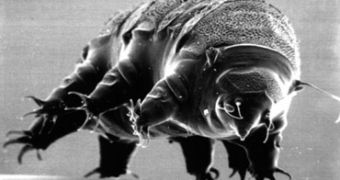You may have heard about scorpions, cockroaches or mice resisting atomic explosions during nuclear tests. "As tough as a bacterium" can turn into a scientific saying. But all these examples are not by far the most resistant organisms on Earth. This honor could be attributed to tardigrades (also called "water bears", a reference to their chubby look when watched under a microscope), a group of animals that form their own phylum, Tardigrada (like, let's say, Vertebrates). Except biologists, perhaps no one has heard about tardigrades ("slow walkers" in Latin). And that's normal, as these tiny creatures vary in body length between 0.1 and 1.5 mm.
Tardigrades look like segmented worms, with 8 pairs of very primitive tubular clawed feet and covered by an exoskeleton presenting pores, papillae, spines and filaments. Depending on their digestive content, tardigrades can be white, pink, purple, green, red, yellow or gray. A pair of spikes allow them to penetrate vegetal or animal tissue, whose liquid they aspire.
Tardigrades can resist temperatures varying between -270?C (-273?C is zero absolute) and 151?C (303?F) - no bacterium is known to survive in such extreme temperature values, not to mention such variation - exposure to X rays 1,000 times higher than values that would kill any other creature, space-like vacuum, or pressures 6 times higher than those found on the bottom of the deepest ocean (7,000 atmospheres). Normally, the freeze destroys membranes, while the heat and radiation destroy chemicals and tissues.
Moreover, tardigrades can stay for decades in a latent stage and revive when conditions are right. Some tardigrades revived 124 years later from dry moss samples in museums when they were exposed to water. When being continuously active, tardigrades live just one year. How can this astonishing resistance be explained? These animals can enter a stage of coma, when their body size reduces by 85 % while losing almost all the water in the body and having no metabolism. This is caused by freeze, decreased oxygen amount or high osmotic pressure.
Over 1000 species of tardigrades are known, and because of this resistance they are encountered over vast areas worldwide, from the high Himalayas (above 6,000 m (20,000 ft), where only some spiders, snow fleas and beetles can resist besides tardigrades), to the deep sea (below 4,000 m) and from polar ice to warm areas.
In fact, in human settlements, they are found everywhere, from roofs to cracks in the slabs, hidden in lichens and mosses. In dunes, beaches, soil and marine or freshwater sediments (there may be 25,000 tardigrades per litre). They also inhabit decomposing freshwater vegetation, but the resulting toxins inhibit their development. Some can live associated with the mollusks in their mantle. With all their resistance, the tardigrades are affected by one issue: pollution. Because of it, they are more common in rural areas than in the cities.

 14 DAY TRIAL //
14 DAY TRIAL //